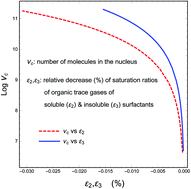Depletion of atmospheric organic trace gases due to their uptake by an ensemble of aqueous aerosols evolving via concurrent condensation and chemical aging
Abstract
In the framework of classical nucleation theory (CNT), we demonstrate that an ensemble of aqueous hydrophilic–hydrophobic organic droplets, containing both soluble and insoluble surfactants and evolving via concurrent condensation and chemical aging, may deplete the surrounding air of low-volatility organic trace gases and thus noticeably decrease their saturation ratios. At a given liquid water content in the air, this depletion becomes stronger with increasing dispersion of the liquid phase, i.e., with increasing collective surface-to-volume ratio of droplets; this dependence becomes particularly sharp for droplets of submicron to micron radii R ≲ 1 μm. One can thus suggest that the adsorption of organic molecules on the surface of droplets may play an important (if not crucial) role in this phenomenon. As a result of such depletion, the height of the nucleation barrier and the size of a critical droplet (nucleus) will sharply increase; with a decrease of ∼0.01% of a saturation ratio, the barrier height and number of molecules in the nucleus both increase by a factor of ∼102. This may trigger the redistribution of condensable matter in the system. Some smaller supercritical, previously growing droplets will become subcritical, evaporating ones, with the newly available condensable matter enhancing the growth of larger droplets. Thus, the uptake of organic trace gases by an ensemble of aqueous organic aerosols may drastically affect their distribution with respect to size and chemical composition. Therefore, a CNT-based theoretical model, taking this effect into account and implemented in atmospheric aerosol models, would allow one to improve the forecasting accuracy of climate models.



 Please wait while we load your content...
Please wait while we load your content...